|
|
Post by us4-he2-gal2 on Jul 12, 2008 8:20:06 GMT -5
Thread Orientation: On this this we can observe various features of Mesopotamian Art and discuss information from secondary sources.
Animal Legged Stands
The question of the occurrence of animal legs in Mesopotamian art came up when I first saw the above piece. I did a digital adaption (right) of the original pictured on left, which is in fact a gray stone cup from Early Dynastic Kish. I was particular taken with the legs on this piece but had little to explain this feature though they looked like the legs of a gazelle or similar animal. I then spoke to Sheshki who had seen a similar feature in a book dealing with the ANE - pictured below: Sheshki made a small note from this publication which dealt with finds from the site of Eshnunna in Semitic Northern Mesopotamia. This is where the three statues with animal legged supports were found - note Kish, which is where the animal legged Cup came from, is also in the Semitic north. The note Sheshki took is from some of the excavators comments on these items, part of which reads: "All the figures wear long beards and are naked except for horizontally striped girdles. From the head of the large figures rises what seems to be a four-armed support for a bowl or similar object. The small figures show traces of similar supports. T he four-legged stand underneath the large figure is the narrowest of the three. A similar copper support, but five legged and used for a stone vase, was found at kish underneath the " inundation clay deposit" and is now in the Baghdad museum.'' In the above, the author has first comment on the 4 arms that protrude from the top of the center statues head - it is a guess that these may have supported a bowl or similar object. I have highlighted to comment which applies to the animal legged stands, and its interesting that here a direct comparison between the Eshnunna statues and the Kish cup is made. One may wonder at this point if this peculiar way of making stands was not special to Semitic ritual objects? These objects seem particular associated with libations and with ritual offers as Sheshki's book also notes "The use of the figures can perhaps best be compared with that of pottery stands found in the archaic Ishtar temple at Assur. In both cases offerings may have been placed upon them. Since votive plaques found at Ur, Nippur, Lagash, and elsewhere show naked priest pouring libations before the gods, we may explain the attitude and attire of our figures by assuming that these offering-stands in the form of priests were placed before the cult statue. " More to follow on this peculiar aspect of Mesopotamian art.. |
|
|
|
Post by us4-he2-gal2 on Jul 12, 2008 13:32:51 GMT -5
Reviewing Edith Porada, CANE IV In flipping through the 4th volume of the massive Civilizations of the Ancient Near East series (CANE) I have come across an retrospective article by Edith Porada, an article in which she reflects on her career and findings. I hadn't previously been well acquainted with this scholar, however on reading I am very interested in her. I have typed the introduction to the article (which is a brief biography of Porada) below:
Edith Porada: Born in Vienna in 1912, Edith Porada received her Ph.D. from its University where, as a student of Viktor Christian, she began her lifelong study of ancient near eastern seals stones. After coming to the United States, Dr. Porada cataloged the near eastern seals in the collection of the Pierpont Morgan Library. The Corpus of Near Eastern Seals in North American Collections, published in 1948, remains a seminal work. Dr. Porada was named honorary Curator of Seals and Tablets at the Morgan Library in 1956. Her teaching career began at Queens Collage, City University of New York; after 1958 she taught in the Department of Art History and Archaeology , Columbia University, where she was Arthur Lehman Professor of Art History and Archaeology. Her many honors, including the Award for Distinguished Archaeological Achievement from the Archaeological Institute of America, were tribute to Dr. Poroda's vast knowledge, pioneering research, and abundant publications on near eastern seals. Until her death on Mach 24, 1994, Dr. Porada contributed imaginatively to a field of study she had founded in the United States.
Extracts from Poradas retrospective article "Understanding Ancient Near Eastern Art: A Personal Account"On the Early Interpretation of Mesopotamian ArtPoroda: "The early history and evaluation of ancient Mesopotamian art were the work of scholars who had been trained in Greek art. Three individuals stand out. The first is Leon Alexandre Heuzey, whose earlier work had been in excavations from Macedonia and who had written on Greek statuary and terra-cottas. .. " Porada tells us that in an early work on Mesopotamian art which Heuzey produced, that author produced side by side an Egyptian Slate Palette and a cylinder seal of about 3000 BC both showing monsters consisting of lions' bodies and serpents' necks to illustrate the relation between these two cultures. She states only in recent times are some relations between Egyptian and Mesopotamian art being established, thus Heuzey early comparison was insightful - at this point it may be worth it to pause and ask just what was he comparing in that particular example? Porada does not elaborate here, however based on some recent reading we may be able to guess. The lion-bodied serpent-necked monster in Mesopotamia: For this strange looking creature we now have information posted by Madness, and can refer to the Ningishzida thread, reply # 54. Here we see Wiggermann's historical development of the Mus-Hussu, and based on figure 2b, it is apparent that a Akkadian Cylinder Seal Sheshki tweaked elsewhere is in fact a depiction of the protoliterate version of the Mus-Hussu (lions body, entwined necks) - See here. Therefore, in Mesopotamian, the lion-body serpent-necked creature = the Mus-hussu. The lion-bodied serpent-necked monster in Egypt: The one time I have had the luxury of visiting the Royal Ontario Museum in Toronto, I recall seeing one particular exhibit over the rest - The Narmar Pallette. While the object at Toronto is just a facsimile, the original is keep in the Cairo Museum and is fascinating. This is a large siltstone piece which is notable for many reasons, among which it contains the earliest depiction of a Pharaoh - Narmar himself (on the reverse.) See the wiki for this object en.wikipedia.org/wiki/Narmer_Palette On the obverse however, we see the subject at hand: A monster with lion-body and snake-necks entwined. For a small discussion on this occurrence I am currently referring to the wiki entry for what is termed Serpopards. Note especially that Egyptian art is said to be known for its 'accurate depictions of creatures observed' and on this page the concluding comment "Depictions of fantastic animals also are known from Elam and Mesopotamia,[1] as well as many other cultures." ..... I therefore believe these are the two traditions of monster, perhaps even the same pieces, that Huezey compared in his early work on Ancient Mesopotamian art.
To follow.. Porada's continuing reflections on her career and her specialization - starting next with the other two individuals she considers to have been pioneering in Mesopotamian art studies. enenuru.net/sheshki/gal/mush-hush.jpg |
|
|
|
Post by us4-he2-gal2 on Jul 13, 2008 2:51:07 GMT -5
(Continued from above: Reviewing Porada, CANE 4) Next we have the second individual who influenced studies Mesopotamia art, and whose career Porada's discusses for us. Walter Andrae: According to Porada, Andrae was an early scholar on Mesopotamian art, who wrote Die Kunst Vorderasiens, which was informed largely on his extensive knowledge of the countries that yielded these artifacts. He was in the beginning much more familiar with Greek art and Mesopotamian exemplars were "dark and foreign" to him. He utilized a rough chronological schema to date different Mesopotamian materials, which were essentially correct in the later dating but which dated the Akkadian and Gudea periods several hundreds years earlier then holds today. Porada: "Andrea linked the sculptures of Gudea (circa 2150 BC...) both those of the period of the Akkad Dynasty (circa 2340 BC.) in the golden age of Mesopotamia. The last work included by Andrae in this golden age was the Stella with the law code of Hammurabi which he lauded for its naturalism and precise rendering of the figures' profile views. " Porada notes that while Andrae had a first looked at ANE art with the preconceptions of Greek aesthetics, by the end of his career he was was describing the "massive fullness" of figures depicted by the Mesopotamians, and about the style of the reliefs of Ashurbanipal II, he states they can only be compared "with the works of Michelangelo". Thus, by the end of his career Andrae "had fully accepted the aesthetics of ancient near eastern art. "Ludwig Curtis: Its explained that Ludwig Curtis was a historian of Greek and Roman art and that the initiative for his explorations came from a desire to detail the influences on Greek art. He was particularly interested in the Assyrian reliefs especially those containing battle or hunting scenes. He would praise these works and describe them as "annals written in pictures." In 1913 he wrote Antike Kunst. Porada: "According to Curtis, the battle and hunting scenes were themes taken over from the archaic style. In the representations of technical procedures, however, the interest of the period itself is evident....He gave equally careful attention to the works of Assurbanipal and concluded that art history ignores these works because they are difficult to access and demand an effort to understand them. Therefore, these great images have not received the place in the history of the world art that is due to them. Though published in 1913, his view is still valid. "
|
|
|
|
Post by us4-he2-gal2 on Jul 17, 2008 11:25:07 GMT -5
Incense burner of Nin-Alla (wife of Gudea): This incense burner bears the Inscription "For the well-being of Gudea, ruler of Lagash, and for her own well-being as well, Nin-Alla, wife of Gudea, had dedicated this incense burner to Bawa, the gracious goddess, her mistress." Some of you may have seen this object before (Sheshki?), I had personally thoguh it beautiful but did not know it was an incense burner. Porada descibes this object as a "beautifully proportioned bowl" adding "the combination of these abstact forms expresses the refined taste of the period." Female statue from the court of Gudea at Tello (2250 BC): (For some commentary on this image, see also the
Mespotamian Fashion in Art thread, reply # 5 Porada: "Curtius called this stype classic becaused it reflected natural forms, as in the soft folds of the garment over the arms, yet noted the hands with th elong fingers folded in a gesture of worship but expressing self-control, thereby creating an expressoin of aristocratic refinement and inner nervous life... Curtius added nothing like this had been seen before the articulation of limbs in archaic Greek art." Comment on Cylinder sea art: Porada informs us that between the Gudea period, and the Neo-Assyrian empire (21st century to early 1st millenium BC.) "Mesopotamian art is largely represented by small cylinder seals." To describe the import of these images, she quotes F.A.M. Wiggermann: "The representations on Old Babylonian seals reflect the religious interests of its bearer: defense against intruding evil, and good relations with the divine court. These themes are the constituting elements of Mesopotamian prayers and incantations of all times."
|
|
|
|
Post by sheshki on Jul 18, 2008 6:46:51 GMT -5
Wow, now thats a nice incense burner. didnt know that gudea had a wife  do you know if there is a line art of the text, ush? |
|
|
|
Post by sheshki on Jul 18, 2008 7:04:56 GMT -5
Animal Legged StandsAt the book "Kunst Mesopotamiens" by A. Champdor i found this picture of a plate made of shell ( 7,5 cm x 4,6 cm ) the books said that it is from the times of the royal graves of ur. a naked and shaved priest infront of a cultic stand , which stands on oxfeets. 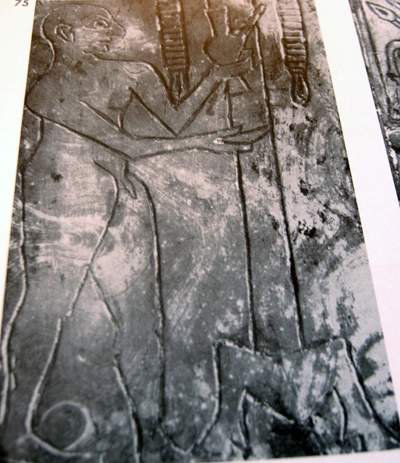 |
|
|
|
Post by sheshki on Jul 19, 2008 18:54:33 GMT -5
In the middle of the picture to the left and right of the figure you can probably see possible upper parts of cultic stands like in the post i made before.  @naomi...no i posted it cuz that guy looks like me...a bit...  |
|
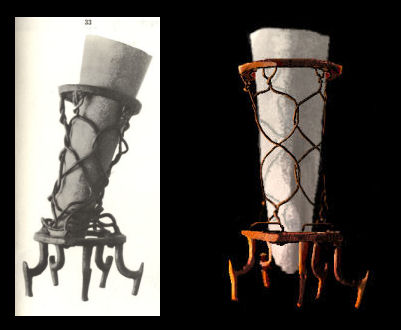





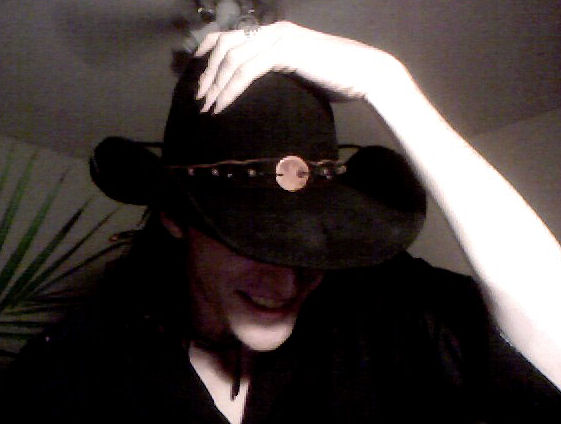
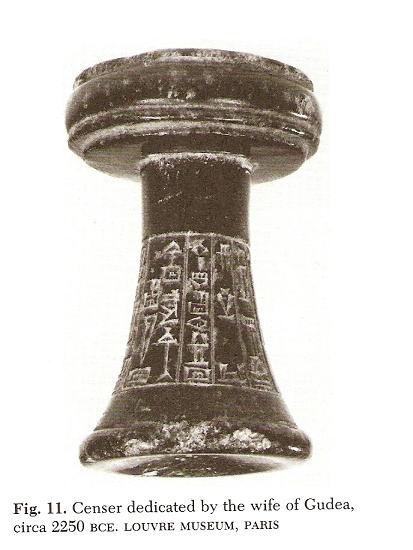
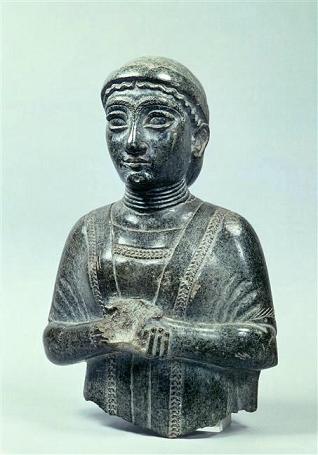


 do you know if there is a line art of the text, ush?
do you know if there is a line art of the text, ush?
